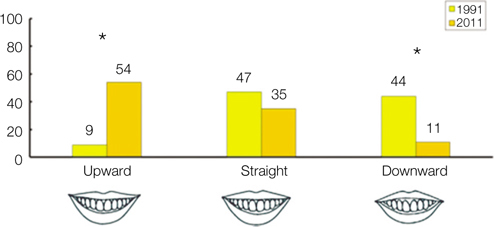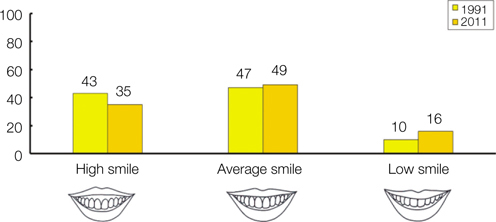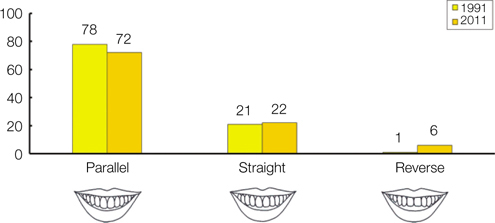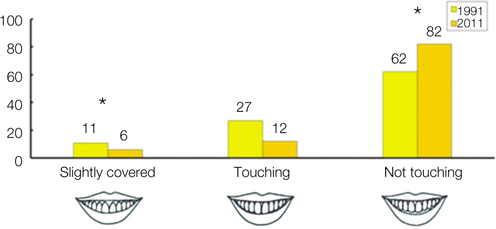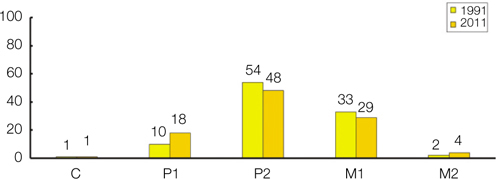J Korean Acad Prosthodont.
2012 Jul;50(3):162-168. 10.4047/jkap.2012.50.3.162.
A study on the smile of Korean Youth compared with twenty years ago
- Affiliations
-
- 1Department of Prosthodontics, College of Dentistry, Wonkwang University, Iksan, Korea. dong@wonkwang.ac.kr
- 2Department of Dentistry, Daejeon St. Marys Hospital, Daejeon, Korea.
- KMID: 2000204
- DOI: http://doi.org/10.4047/jkap.2012.50.3.162
Abstract
- PURPOSE
Teeth are generally exposed when people smiling. Moreover, the exposed teeth and soft tissue when smiling becomes an important guideline for esthetically prosthetic restoration. This research is to compare and find out differences of Korean young men's smile living in presence and twenty years ago.
MATERIALS AND METHODS
Subjects, 100 young men (50 male and 50 female), were required about several aspects; normally developed physical condition, no psychological or genetic disorders, a fine face with no loss of teeth, no experience in orthodontic or prosthetic treatment, relatively normal occlusion, aged between 20 - 29. The photos of the subject at rest position and front face when fully smiled were taken three times. 100 photos (50 male and 50 female) were chosen at random from the 240 university students' smile photos taken by Yoon and his colleagues in 1991. By Hulsey's method of measuring smile, several factors; the change of upper lip curvature, the change of the relation between the upper lip and teeth, parallelism between Mx. incisor and lower lip, contact relation between Mx. incisor and lower lip and teeth displayed in a smile, were measured and analyzed. Meanwhile, ten dentists assessed aesthetic evaluation about men and women's smile for twice and recorded and compared smile score. The -test (P<.05) was used to compare the measured value. The difference of smile score was analyzed by t-test (P<.05).
RESULTS
The smile score calculated in 2011 (60.22) was higher than that of 1991 (52.80). Among five measurement categories, the noticeable difference was distinguished from two factors; the change of upper lip curvature and contact relation between Mx. incisor and lower lip.
CONCLUSION
The Korean young men's smile has been considerably improved for twenty years. And it is found that the change of upper lip curvature plays an important role, that is, the smile formed with an ascended labial commissure has been increased significantly.
Keyword
Figure
Reference
-
1. Robbins JW. Differential diagnosis and treatment of excess gingival display. Pract Periodontics Aesthet Dent. 1999. 11:265–272.2. Tjan AH, Miller GD, The JG. Some esthetic factors in a smile. J Prosthet Dent. 1984. 51:24–28.
Article3. Dion K, Berscheid E, Walster E. What is beautiful is good. J Pers Soc Psychol. 1972. 24:285–290.
Article4. Rufenacht CR. Fundamentals of esthetics. 1990. Chicago: Quintessence;67–134.5. Moskowitz ME, Nayyar A. Determinants of dental esthetics: a rational for smile analysis and treatment. Compend Contin Educ Dent. 1995. 16:1164. 1166.6. Tjan AH, Miller GD, The JG. Some esthetic factors in a smile. J Prosthet Dent. 1984. 51:24–28.
Article7. Moore T, Southard KA, Casko JS, Qian F, Southard TE. Buccal corridors and smile esthetics. Am J Orthod Dentofacial Orthop. 2005. 127:208–213.
Article8. Broadbent TR, Mathews VL. Artistic relationships in surface anatomy of the face: application to reconstructive surgery. Plast Reconstr Surg (1946). 1957. 20:1–17.
Article9. Farkas LG, Katic MJ, Hreczko TA, Deutsch C, Munro IR. Anthropometric proportions in the upper lip-lower lip-chin area of the lower face in young white adults. Am J Orthod. 1984. 86:52–60.
Article10. Nakajima E, Yanagisawa M. The Japanese sense of beauty and facial proportions. I. The facial characteristics of people with malocclusions. Quintessence Int. 1985. 8:553–557.11. Nakajima E, Yanagisawa M. The Japanese sense of beauty and facial proportions. II. The beautiful face and the root 2 rule. Quintessence Int. 1985. 9:629–637.12. Nakajima E, Maeda T, Yanagisawa M. The Japanese sense of beauty and facial proportions, III. The facial proportion check sheet. Quintessence Int. 1985. 10:715–721.13. Yuen SW, Hiranaka DK. A photographic study of the facial profiles of southern Chinese adolescents. Quintessence Int. 1989. 20:665–676.14. Peck S, Peck L, Kataja M. Some vertical lineaments of lip position. Am J Orthod Dentofacial Orthop. 1992. 101:519–524.
Article15. Hulsey CM. An esthetic evaluation of lip-teeth relationships present in the smile. Am J Orthod. 1970. 57:132–144.
Article16. Yoon ME, Jin TH, Dong JK. A study on the smile in Korean youth. J Korean Acad Prosthodont. 1992. 30:259–271.17. Heravi F, Rashed R, Abachizadeh H. Esthetic preferences for the shape of anterior teeth in a posed smile. Am J Orthod Dentofacial Orthop. 2011. 139:806–814.
Article18. Anderson KM, Behrents RG, McKinney T, Buschang PH. Tooth shape preferences in an esthetic smile. Am J Orthod Dentofacial Orthop. 2005. 128:458–465.
Article19. Van der Geld P, Oosterveld P, Van Heck G, Kuijpers-Jagtman AM. Smile attractiveness. Self-perception and influence on personality. Angle Orthod. 2007. 77:759–765.20. Kim HS, Kim IP, Oh SC, Dong JK. The effect of personality on the smile. J Wonkwang Dent Res Inst. 1995. 5:299–314.
- Full Text Links
- Actions
-
Cited
- CITED
-
- Close
- Share
- Similar articles
-
- A study on the smile in Korean youth
- Evaluation of the lip during smile in normal occlusion adults
- Smart Device-Assisted Visually Guided Smile Design: A Case Report
- Comparison of the Early Clinical Outcomes between Combined SMILE and Collagen Cross-linking versus SMILE
- Treatment of gummy smile using botulinum toxin: a review

